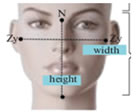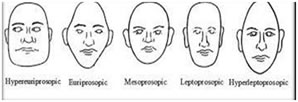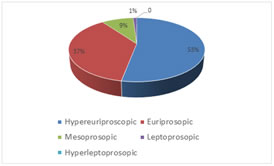|
Table of Content - Volume 20 Issue 1 - October 2021
Distribution of face type in Guajarati female -Anthropometric study
Uttekar Kanan G
Associate Professor, Department of Anatomy, SMIMER, Surat, INDIA. Email: kannanrahulsurve@yahoo.co.in
Abstract Background: Human face and its type has been studied in various races which give facial anthropologist, cybercrime expert and reconstructive surgeon an valuable guidline for identification of race and ethnicity of individual in the present study 412 gujarati female face has been studied for facial Index in which the facial index was found to be 82 with predominant face type being Hypereuriproscopic Key word: facial index, Hypereuriproscopic Euriprosopic Mesoprosopic Leptoprosopic Hyperleptoprosopic
INTRODUCTION Face is an important physiognomic feature of human. Since ancient time the face carry an important aesthetic position in human anatomy. Measurement and evaluation of human face is an important criterion for assessment of various information like age, gender, race and geological zone2,3. With the global digitalization it has become necessary to have face reorganisation system in each and every field of human life. Facial reorganisation has become important factor as personal identity proof.8 As per the standard anthropometric classification human face is classified in to basic four type of group with In the present is aimed to study digital anatomical and anthropometric character of female face and to categorize them in different type which will serve as basic research various upcoming branches of medicine and technology17 Facial Anthropometric studies have been conducted by various scientists across the world since decades 4. with the evolution of artificial intelligence and biometric has become necessary to have baseline data for face type and face distribution Cephalometry has become an important branch of anthropometry in which deals with dimensions of head and face are measured. Cephalometric analysis are useful in forensic medicine, Plastic surgery, Oral surgery and diagnostic comparisons between patient and normal populations.23 World over good quality photographs has replaced the conventional assessment method of anthropometric measurement. Photographic documentation used in the present study is the most convenient and helpful method for facial analysisthis method of study is easy, subject friendly and reduces human error and large number of populations can be studied. Present study has been conducted in Gujarati population to study face type of female of Gujrat the aim of the study has been done to to investigated face type and its predominance in Gujarati female. Facial index of particular race is required in every developing branch of anatomy from forensic medicine to reconstructive surgery , from anthropometry to plastic surgery, from cyber crime to medicolegal cases. Face is an important guid for identification in all this branches.
MATERIALS AND METHODS Present study was conducted in various regions of Gujarat, India. After the ethical clearance of the institutional ethical committee the data collection was started. Adult females between the age group of 18 to 25 years residing in Gujarat were selected randomly with written consent for the study. Consent was obtained from individuals after explaining the procedure to them. All females and their forefathers were belonging to Gujarat and they were all pure breeds. Selection criteria included pleasing face with no craniofacial abnormality. None of individual underwent any plastic, maxillofacial or reconstructive surgery. Total 412 female from Details about individuals, origin of parents, grandparents were collected. Frontal Photographic documentation was done with the help of 10 mega pixel digital camera. Tripod was used to adjust the height of individuals in Frankfurt’s horizontal plane. A round was marked on the floor in which each subject stood. Each documentation was taken in normal day light. Before taking every document, the operators ensured that all the desired landmark were clearly visible. Photographs were subjected to soft tissue anthropometric software system designed in MATLAB Version7. Magnification of photograph was life size. Photographs were analysed by single researcher for standardization. All soft tissue landmarks were reproduced on the photograph using software. The analysed data were taken on Microsoft excel file. The collected data was analysed using SPSS version 10. Facial measurements (Fig 1) Facial Length – It is distance between Nasion (n) to Menton (mn) Face Width – It is distance between Zygoin (zy) of Right and Left side. Facial Index (Prosopic Index)- Face length (nmn)/face width (zy-zy) X 100 The above index was determined based on international anatomical descriptions (4) Based on the facial index the different types of face were categorized according to Banister classification 2 (Fig 2). Hypereuriproscopic means Facial index is lesser than or equal to 79.9 Euriprosopic means facial index is between 80 to 84.9. Mesoprosopic means facial index is between 85 to 89.9. Leptoprosopic means facial index is between 90 to 95. Hyperleptoprosopic means facial index is more than 95.
RESULTS The study results shows that the mean and standard deviation of Facial index in Gujarati females was 85 (Table 1). Minimum facial index was 78 and maximum was 85. Standard deviation was 3.3. The dominant type of female face was hypereuriprosopic (42.96%) and rare type of face was Leptoprosopic (3.64%) Hyperleptoprosopic type of faces was not found in present study. (Table 2) Table 1: Mean, Standard Deviation, Maximum and Minimum values for Facial Index Variable Mean Standard Deviation Maximum Minimum Facial Index 81.7 4.2 87.5 80 Table 2: Distribution of Face type in Gujarati females. Type of Face Hypereuriproscopic Euriprosopic Mesoprosopic Leptoprosopic Hyperleptoprosopic Gujarati female was 53% 37.96%, 9.35% 1.64%, 0% Figure 1: Showing Landmark Nasion, Zygoin (Right and Left), Menton
Figure 2: types of face
Table 1: Mean, Standard Deviation, Maximum and Minimum values for Facial Index
Table 2: Distribution of face type in Gujarati Female
Graph 1: Distribution of face type in females of Gujarat
DISCUSSION The facial dimensions are expressed by facial index which is ratio of face length to face width. In this study mean facial index of Guajarati female was found to be Present study revealed that mean facial index of Gujarati female was 82where as in Iranians dominant type of face was Mesoprosopic in female and Euriprosopic in male in study of Farahani et al. 8 Whereas Heidari et al.10,11 Sistani and Baluchi women dominant type of face were Euriprosopic (42%). None of the result matches with our findings. According to Seher Arslan et al.16 major type of face in Turkish female was Euriprosopic which do not match with our study In one of the study Newborn of Turkmans and Fars by Heidari et al.10 had Hypereuriproscopic type of face whereas the adult of same race had Mesoprosopic type of face which suggests the developmental pattern. Such findings should be further investigated in different group which could be very useful to study growth pattern of face. Far and turkman ethenic group showed eurporsopic predominance in the study of jahanshahi et al. 13 Mean facial index in Turkman female was 81 which was less than Gujarati female. In an sty of ghosh et al. 12 on santhal of west bangal it was found that major population was hypereuroprosopcic and euryprosopic type which consider with out study Bhasin et al.14 in population of Maharashtra studied only the distribution of face type found that predominant type of face was mesoprosopic with the 32% of population which is contradictory to present study Shetti et al. 20 found in Indian female that mesoprosopic and euryprosopic was the comments type of face which differ from our results As per the study of osunwoke et al.22 nigerian population show sexual dimorphism and signigicant difference in between male and female of which coindice with our study on gujarati female Kurnia et al.11 in his study on china found that mean facial index for female was 88 which is higher than present study and also the dominant type of face in their study was mesoprosopic which in our study is hype euriprosopic Where as salve et al.10 in his study on Indian population found the predominant type of fce in female was euriprosopic Praveen kuman doni et35 al in south Indian population found dominant type of face was hyperleptoprosopic which is one of the not found face in Guajarati female
CONCLUSION Data obtained from this study will be an useful guideline for further research in forensic and reconstructive medicine. such data is also useful in identifying nationality and race of individual from face in world over with will definitely help people for the medicolegal and cyber crime also
REFERENCES
Policy for Articles with Open Access
|
|
 Home
Home



